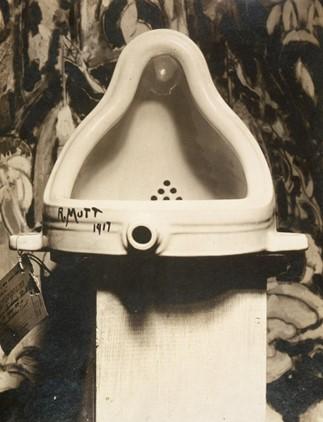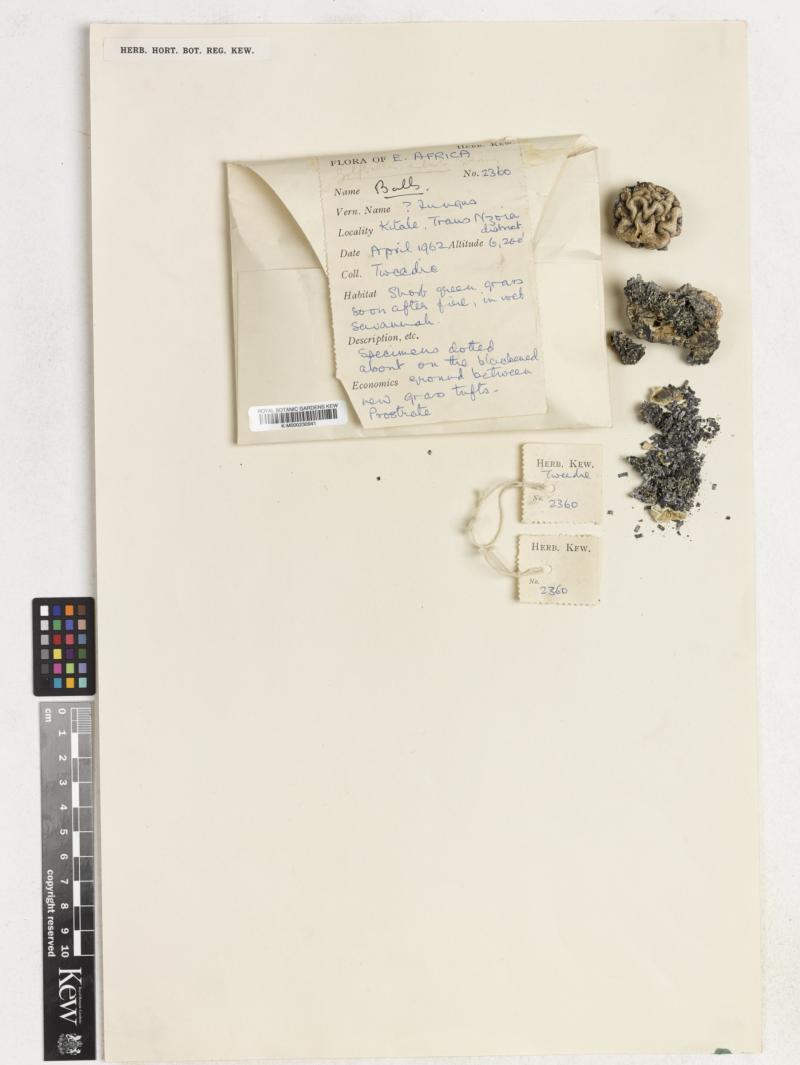In arguably the most defining moment of Dadaist art, Marcel Duchamp (1887–1968), under the pseudonym R. Mutt, submitted Fountain, a mass-produced urinal, to the inaugural exhibition of the Society of Independent Artists to be displayed at the Grand Central Palace in New York in 1917 (Figure 1). When the original was rejected for display and subsequently lost, it did not matter; Duchamp merely put his name to other urinals. Neither the object nor the process mattered—an object became art through the signature of the artist alone.

Fig. 1. Image of the original Fountain by R. Mutt [Marcel Duchamp].
Fig. 1. Image of the original Fountain by R. Mutt [Marcel Duchamp].
Photo by Alfred Stieglitz, 1917.Originally published with the caption “The Exhibit Refused by the Independents” in The Blind Man, no. 2, May 1917, https://monoskop.org/images/6/6f/The_Blind_Man_2_May_1917.pdf.
 This work is licensed under a Creative Commons Public Domain Mark 1.0 License.
This work is licensed under a Creative Commons Public Domain Mark 1.0 License.
A similar event occurred in 1962, when Richard William George Dennis (1910–2003; Figure 2), Head of Mycology at Royal Botanic Gardens, Kew, published an article titled “A Remarkable New Genus of Phalloids in Lancashire and East Africa” in the Journal of the Kew Guild. The article describes the discovery of a new species submitted to the Kew Fungarium, a global center for fungal taxonomy, for identification by several collectors who, showing “praiseworthy modesty,” had chosen to remain anonymous. It had been found once in Lancashire, England, and several times in East Africa and closely resembled “certain small, hard but elastic, spheres enjoyed by the Caledonians in certain tribal rites,” with a distinct odor described as “old or heated India rubber.” The punch line, placed at the end of the article, occurs when, as is tradition, the species is formally described and is given the Latin binomial Golfballia ambusta.
The article followed a long line of mycological jokes and hoaxes. A previous mycologist at Kew, George Edward Massee (1845–1917), was known to deliberately, and playfully, take highly contradictory mycological and scientific views to “stir up the hornet’s nest.” He also produced several questionable recordings of species new to Britain and self-confessed (though never publicly) to fabricating several fungal illustrations supposedly drawn from life. Across the pond, Curtis Gates Lloyd (1859–1926) recruited the alias of Professor McGinty to maliciously describe new species—with both the character and his publications working as a form of “disrespectful satire” toward mycologists that Lloyd disagreed with.
But Dennis went further than a hoax article. He maintained several collections of the “fungus” and curated and deposited them in the Kew Fungarium amongst the genera incertae sedis (a term applied to organisms whose relationship to other species is unknown). The “fungi” were formally accessioned (Accession Numbers K(M)230939–K(M)230941; Figures 3 and 4) and validly published in a printed journal. The result is that both to the outside observer and according to the rules and recommendations of the then-current version of the International Code of Nomenclature for Algae, Fungi, and Plants, Golfballia ambusta is a legitimate species.

Fig. 2. Photograph of Richard William George Dennis.
Fig. 2. Photograph of Richard William George Dennis.
Reproduced from the article “Richard William George Dennis (1910–2003): Mycologist and Savant” by Brian M. Spooner and Peter J. Roberts in Mycological Research 108, no. 9 (2004) with kind permission from the British Mycological Society, https://doi.org/10.1017/S0953756204000711.
The copyright holder reserves, or holds for their own use, all the rights provided by copyright law, such as distribution, performance, and creation of derivative works.
In contrast to previous mycological hoaxes, Dennis’s claim was not to have discovered a species where one did not exist or expand the range of known fungi. Rather, in true Dadaist fashion, Dennis challenged (and undermined) the very understanding of what a fungus is by declaring that a fungus was whatever a mycologist decided it to be; any object was made a fungus through the signature of a mycologist alone.
Such a claim is particularly important in mycology, where the definition of a fungus is both hazy and in flux. Whilst the uppercase Fungi exists, representing the formal and genetically distinct Kingdom of Fungi, the more common understanding of (lower-case) fungi encapsulates a broad range of unrelated organisms that are “fungal-like.” Several mycologists, including Nicholas Money, have argued that organisms such as slime molds and oomycetes may all be considered fungi because they have many similar physiological processes and, in a rather circular logic, because they are “micro-organisms studied by mycologists.” Other organisms, such as the unicellular microsporidia, sit on the thresholds of the Kingdom and are designated Fungi depending on prevailing understandings and opinion of the earliest-diverging groups of the Fungal tree of life. Neither Fungi nor fungi, then, are fixed or easily definable. As such, while Dennis’s concept Golfballia ambusta may be provocative, it is a struggle to explain what exactly it offends.
Duchamp conceived Fountain partially to challenge the exhibition’s organizers, who claimed that all art submitted to them would be displayed—a claim ultimately proven false. The power of Fountain thus came, in part, from its ability to expose hypocrisy in artistic movements and to force a definition of what was, and was not, art—allowing the boundaries to be challenged. Golfballia ambusta, in equally playful fashion, exposes the variable premises of identification in mycology.

Fig. 3. Preserved specimens of Golfballia ambusta affixed to sheets.
Fig. 3. Preserved specimens of Golfballia ambusta affixed to sheets.
Accession number K(M)230904. Courtesy of the Royal Botanic Gardens, Kew. Used by permission.
The copyright holder reserves, or holds for their own use, all the rights provided by copyright law, such as distribution, performance, and creation of derivative works.

Fig. 4. Preserved specimens of Golfballia ambusta affixed to sheets.
Fig. 4. Preserved specimens of Golfballia ambusta affixed to sheets.
Accession number K(M)230941. Courtesy of the Royal Botanic Gardens, Kew. Used by permission.
The copyright holder reserves, or holds for their own use, all the rights provided by copyright law, such as distribution, performance, and creation of derivative works.
Less playful, perhaps, are recent attempts by some mycologists to move toward the descriptions of new fungal species through genetic sequence alone. This not only presents numerous technical issues but also more social ones regarding the accessibility of mycology to amateur participants. In trying to describe DNA-only species, several mycologists appealed to rules in the Code that allowed an illustration to substitute the presence of a physical specimen in describing a species—a rule primarily designed to grandfather in older descriptions—arguing that a genetic sequence functioned as an illustration. After all, if a golf ball can be a fungus, then surely a sequence of letters can be an illustration.
Such efforts were ultimately unsuccessful, with the Code being updated to render such attempts illegitimate, but both Dennis’s golf-ball fungus and the later attempts to redefine illustration have put a Dadaist conundrum at the heart of mycological taxonomy. If a mycologist may decide anything is a fungus, then it no longer matters what a species is. Instead, the more pertinent question to ask is: who is a mycologist?
How to cite
Smith, Nathan. “What Is a Fungus? Mycology’s Dada Moment.” Environment & Society Portal, Arcadia (Spring 2023), no. 5. Rachel Carson Center for Environment and Society. doi:10.5282/rcc/9598.
ISSN 2199-3408
Environment & Society Portal, Arcadia
 This work is licensed under a Creative Commons Attribution 4.0 International License.
This work is licensed under a Creative Commons Attribution 4.0 International License.
2023 Nathan Smith
This refers only to the text and does not include any image rights.
Please click on an image to view its individual rights status.
- Camfield, William A. “Marcel Duchamp’s Fountain: Its History and Aesthetics in the Context of 1917.“ Dada/Surrealism 16, no. 1 (1987): 64–71.
- Dennis, Richard William George. “A Remarkable New Genus of Phalloids in Lancashire and East Africa.” Journal of the Kew Guild 8 (1962): 181–82.
- Lücking, Robert, and David L. Hawksworth. “Formal Description of Sequence-Based Voucherless Fungi: Promises and Pitfalls, and How to Resolve Them.” IMA Fungus 9 (2018): 143–65. doi:10.5598/imafungus.2018.09.01.09.
- Money, Nicholas P. “Why Ooycetes Have Not Stopped Being Fungi.” Mycological Research 102, no. 6 (1998): 767–68. doi:10.1017/S095375629700556X.
- Nelson, E. Charles. “Some Botanical Hoaxes and Chinese Puzzles.” The Kew Magazine 3, no. 4 (1986): 178–85.
- Smith, Nathan E. C. “Narrative Histories in Mycology and the Legacy of George Edward Massee (1845–1917).” Archives of Natural History 47, no. 2 (2020): 361–80. doi:10.3366/anh.2020.0661.
- Spooner, Brian M., and Peter J. Roberts. “Richard William George Dennis, 1910–2003.” Mycologia 96, no. 1 (2004): 187–89.








